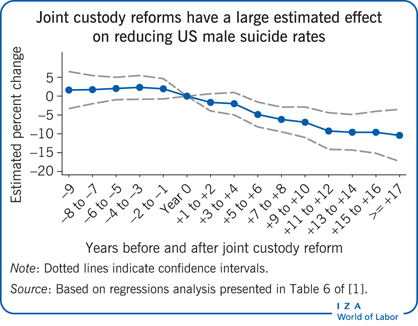Elevator pitch
Custody laws governing living arrangements for children following their parents’ divorce have changed dramatically since the 1970s. Traditionally, one parent—usually the mother—was assigned sole custody of the child. Today, many divorced parents continue to share parental rights and responsibilities through joint custody arrangements. While joint custody laws have improved the situation of divorced fathers, recent empirical research has documented intended and unintended consequences of joint custody laws for families in such areas as family formation, labor force participation, suicide, domestic violence, and child outcomes.
Key findings
Pros
The introduction of joint custody reforms boosts marriage rates, particularly among people with previous divorce experience and those aged 35 or older.
Joint custody reforms have increased overall fertility rates and shifted fertility from outside marriage to inside marriage.
Joint custody reforms have lowered male suicide rates by about 9% over the long term.
Joint custody reforms have reduced the incidence of domestic violence.
Children of divorced parents growing up under joint custody reforms may have higher educational attainment.
Cons
The introduction of joint custody reforms reinforces the traditional division of labor within the family and gives men greater bargaining power over the intra-household allocation of resources.
There is some evidence that joint custody reforms increase divorce rates.
Joint custody reforms reduce female labor market participation.
Joint custody reforms have had no robust, long-term effect on female suicide rates.
Children overall and those in intact families growing up in jurisdictions with joint custody laws have lower educational attainment and worse labor market outcomes.
